
Здравствуйте, гость ( Вход | Регистрация )
| Here You Can Support Our Work and .:LavTeaM:. Services |
| Дата поста: | В теме: | За сообщение: | Спасибо сказали: | ||
|---|---|---|---|---|---|
| 5.10.2025 - 11:47 | Строительное проектирование | Floor Deck Design Manual Second Edition – No. FDDM2 Steel Deck Institute, 2020 pdf, 356pages, English ISBN: -  Description June 2020 – The Second Edition of the SDI Floor Deck Design Manual (FDDM2) supersedes and enhances its predecessor, integrating the updated 2017 ANSI/SDI Design Standards and aligning with the 2018 and 2021 IBC codes. FDDM2 introduces valuable additions, such as load tables and design examples specifically for concentrated loads and scissor lift-type moving loads. Notably, the load tables have been optimized for improved readability. Furthermore, this edition incorporates considerations for sound transmission and impact, providing a comprehensive resource for sound structural design using floor deck systems. Download » Click to show Spoiler - click again to hide... «
|
ashraf_1969, | ||
| 15.08.2025 - 04:32 | Строительное проектирование | AISC Design Guide 6: Composite Column Design (Second Ed.) American Institute of Steel Construction, 2025 pdf, 118 pages, English ISBN: -  Description This new edition of Design Guide 6 provides updated and expanded information on the design of steel-concrete composite columns. Guidance for designing and detailing encased composite columns has been updated and expanded to reflect the modern requirements of the 2022 AISC Specification. This new edition now also includes direction for designing square, rectangular, and round filled composite columns. Additionally, guidance has been given for designing square and rectangular filled composite columns with high-strength materials. Thorough design examples are included for each of these composite column types. Recommendations for designing connections to composite columns are provided. A modern spreadsheet-based tool is also provided to assist with calculating available axial, flexural, and shear strengths of composite members. Download » Click to show Spoiler - click again to hide... «
|
dell001, Williams, | ||
| 19.05.2025 - 03:38 | Строительное проектирование | ACI CODE-318-25: Building Code for Structural Concrete- Code Requirements and Commentary (Inch-Pound Units) American Concrete Institute, 2025 pdf, 712 pages, English ISBN: 9781641953092  Description The “Building Code for Structural Concrete” (“Code”) provides minimum requirements for the materials, design, and detailing of structural concrete buildings and, where applicable, nonbuilding structures. The Code was developed using a consensus process and addresses structural systems, members, and connections, including cast-in-place, precast, shotcrete, plain, nonprestressed, and prestressed, construction. Among the subjects covered are: design and construction for strength, serviceability, and durability; load combinations, load factors, and strength reduction factors; structural analysis methods; deflection limits; mechanical and adhesive anchoring to concrete; development and splicing of reinforcement; construction document information; field inspection and testing; methods to evaluate the strength of existing structures; design verification using nonlinear response history analysis in Appendix A; performance-based wind design in Appendix B, and sustainability and resilience in Appendix C. Uses of the Code include adoption by reference in a general building code, and earlier editions have been widely used in this manner. The Code is written in a format that allows such reference without change to its language. Commentary is provided for background information and further explanation of the code requirements. Cited references provide research data useful in studying technical issues in greater detail. Other references, provide greater insight into the code the requirements. Technical changes from ACI CODE-318-19 to ACI CODE-318-25 are indicated by change bars in the margins of the print and PDF versions. Technical changes from ACI CODE-318-19 to ACI CODE-318-25 may also be viewed in red highlights within the PLUS version (https://www.concrete.org/publications/aci318plus.aspx). Special thanks to Bentley Systems, Incorporated, for use of their ProConcrete software to produce many of the figures found in the Commentary. Download |
Williams, | ||
| 16.01.2025 - 04:17 | Строительное проектирование | Reinforced Concrete: Mechanics and Design 8th Edition Pearson, 2021 pdf, 1086 pages, English ASIN: B097T4QZ26  Description Reinforced Concrete uses the theory of reinforced concrete design to teach the basic scientific and artistic principles of civil engineering. Examples and practice problems help you develop your engineering judgment and apply complicated engineering concepts to real-world scenarios. Download |
ashraf_1969, Kong chandamuny, Williams, | ||
| 7.09.2024 - 08:56 | Строительное проектирование | Steel Connection Design by Inelastic Analysis Wiley, 2024 pdf, 472 pages, English ISBN: 1394222157  Description Comprehensive resource on the finite element method in structural steel connection design through verification with AISC 360 provisions Steel Connection Design by Inelastic Analysis covers the use of the finite element method in structural steel connection design. Verification with AISC 360 provisions is presented, focusing on the Component-Based Finite Element Method (CBFEM), a novel approach that provides the global behavior and verification of resistance for the design of structural steel connections. This method is essential for fast and practical design and evaluation of connections with different levels of geometry and complexity. Detailed modeling and verification examples with references to AISC and other relevant publications are included throughout the text, along with roughly 250 illustrations to aid in reader comprehension. Readers of this text will benefit from understanding at least the basics of structural design, ideally through civil, structural, or mechanical engineering programs of study. Written by a team of six highly qualified authors, Steel Connection Design by Inelastic Analysis includes information on: T-stub connections, single plate shear connections, bracket plate connections, beam over column connections, and end-plate moment connections Bolted wide flange splice connections, temporary splice connections, and chevron brace connection in a braced frame Brace connections at beam-column connection in a braced frame and double angle simple beam-to-column connections Semi-rigid beam-to-column connections, covering code design calculations and comparisons, IDEA StatiCa analysis, and ABAQUS analysis Steel Connection Design by Inelastic Analysis is an authoritative reference on the subject for structural engineers, Engineers of Record (EORs), fabrications specialists, and connection designers involved in the structural design of steel connections in the United States or any territory using AISC 360 as the primary design code. Download |
Williams, | ||
| 22.04.2024 - 04:19 | Строительное проектирование | Fluid Viscous Dampers : General Guidelines for Engineers Including a Brief History (2024 Edition) Taylor Devices Inc, 2024 pdf, 327 pages, English ISBN: - 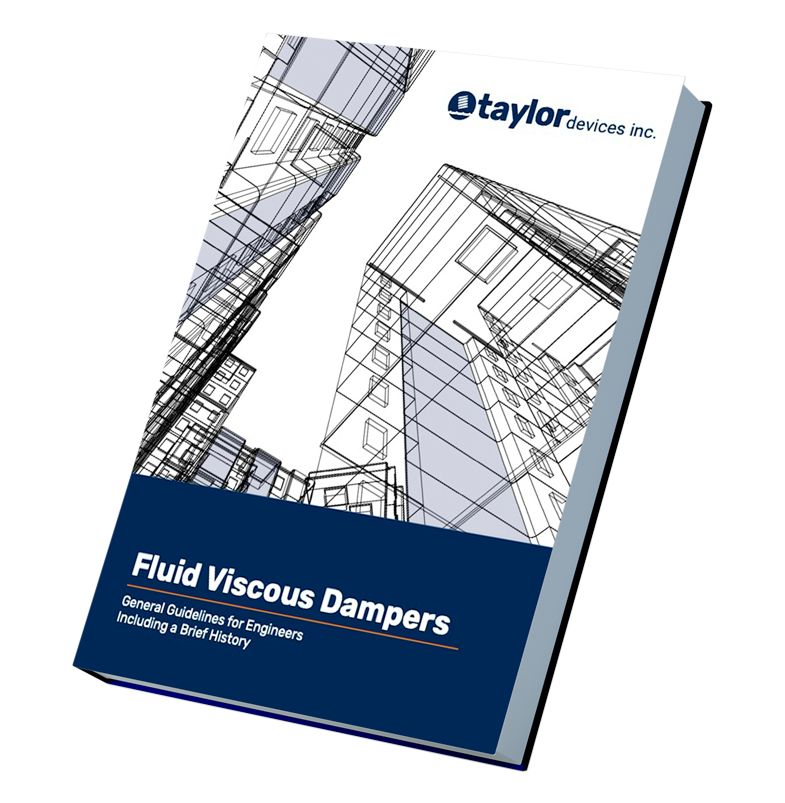 Description What’s Included: Over 300 pages of quality information compiled from over 30 years of project experience. Product information and specifications on Taylor Dampers. Literature, guides, and additional resources to aid you in your design. Case Studies and photographs from actual projects. Download » Click to show Spoiler - click again to hide... «
|
ashraf_1969, ronyleonel, totolemoco, | ||
| 9.04.2024 - 16:42 | Строительное проектирование | AISC Companion to the AISC Steel Construction Manual v16.0 AISC Press, 2023 pdf, 1054 pages + 774, English ISBN: -  Description The v16.0 Companion to the AISC Steel Construction Manual is a two-volume set that supplements the 16th Edition Steel Construction Manual and is keyed to the 2022 Specification for Structural Steel Buildings. The v16.0 Companion is an update of the v15.1 Companion. Volume 1: Design Examples, includes complete design examples illustrating commonly used provisions in the 2022 Specification for Structural Steel Buildings and the 16th Edition Manual for designing members, connections, and structural systems. (1050 pp) Volume 2: Design Tables, supplements the Manual with several additional member and connection design tables. Highlights of Vol. 2 include compression tables for composite HSS columns and the combined loading table for W-shapes. Additionally, the combined axial, shear, flexural, and combined forces "super table" included in Steel Construction Manual Table 6-1 is expanded in Vol. 2 for 65 and 70 ksi W-shapes, and HSS members with both ASTM A500 Gr. C and ASTM A1085. Tables are reproduced in full color. (770 pp) Download The Vol. 1 » Click to show Spoiler - click again to hide... «
Download The Vol. 2 » Click to show Spoiler - click again to hide... «
|
Heatley, totolemoco, | ||
| 2.02.2024 - 19:03 | Строительное проектирование | Structural Stability and Its Computational Modelling Springer Cham, 2024 pdf, 279 pages, English ISBN: 978-3-031-36072-5  Description The volume showcases how basic formulation and solution methods can be used for an improved understanding of stability-affected structures. It also highlights the numerical treatment of the resulting equations, demonstrating and quantifying many aspects of structural stability not available to engineers by the traditional methods. The elaborated theoretical background is also used to show how methods included in commercial software can give misleading conclusions. The book will be of interest to researchers and professionals working in computational modelling of structures. The book includes exercises and projects, appended to each chapter, which further extends its usability as a text book in classroom teaching and for professional courses. Download The Book » Click to show Spoiler - click again to hide... «
|
Kong chandamuny, ronyleonel, totolemoco, Williams, Ал1965, | ||
| 10.01.2024 - 10:46 | Component-based Finite Element Design of Steel Connections | Component-based Finite Element Design of Steel Connections Czech Technical University in Prague, 2020 pdf, 249 pages, English ISBN: 978-80-01-06703-1 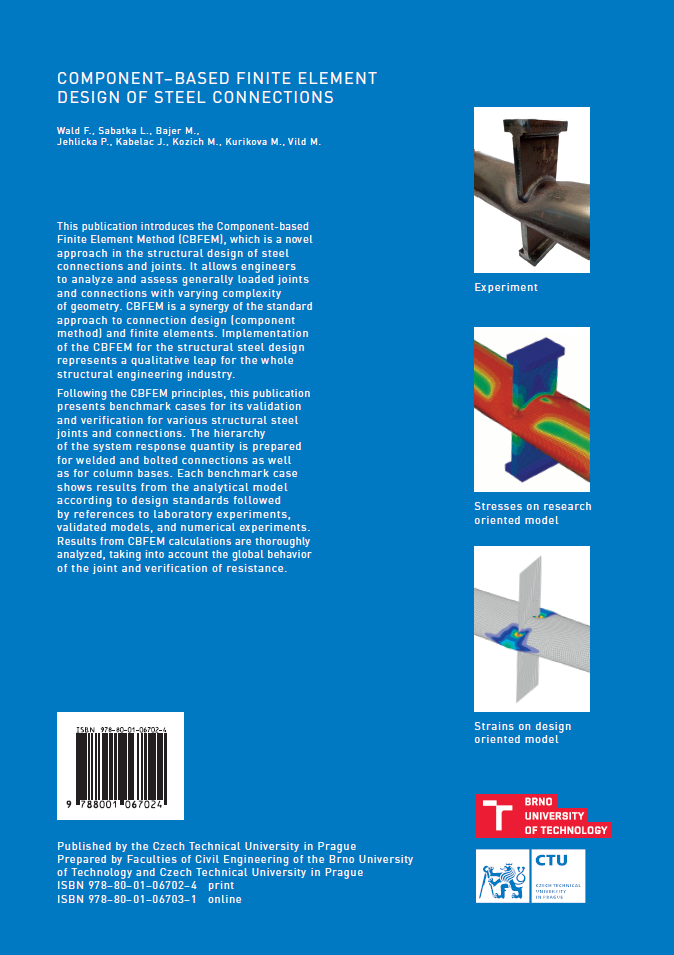 Description This publication introduces the Component-based Finite Element Method (CBFEM), which is a novel approach in the structural design of steel connections and joints. It allows engineers to analyze and assess generally loaded joints and connections with varying complexity of geometry. CBFEM is a synergy of the standard approach to connection design (component method) and finite elements. Implementation of the CBFEM for the structural steel design represents a qualitative leap for the whole structural engineering industry. Following the CBFEM principles, this publication presents benchmark cases for its validation and verification for various structural steel joints and connections. The hierarchy of the system response quantity is prepared for welded and bolted connections as well as for column bases. Each benchmark case shows results from the analytical model according to design standards followed by references to laboratory experiments, validated models, and numerical experiments. Results from CBFEM calculations are thoroughly analyzed, taking into account the global behavior of the joint and verification of resistance. DOWNLOAD |
2ak2, ailuros, Kong chandamuny, malc, netsonicyxf, rigidjoint, | ||
| 16.12.2023 - 08:16 | Строительное проектирование | Seismic Evaluation and Retrofit of Existing Buildings: ASCE/SEI 41-23 ASCE Press, 2023 pdf, 567 pages, English ISBN: 9780784484760  Description Sponsored by the Seismic Evaluation and Retrofit of Existing Buildings Committee of the Codes and Standards Activities Division of the Structural Engineering Institute of ASCE In Seismic Evaluation and Retrofit of Existing Buildings, ASCE/SEI 41-23, a three-tiered process is established for seismic evaluation according to a range of building performance levels. Tier 1 evaluation focuses on identifying potential deficiencies in existing buildings based on the performance of similar buildings during past earthquakes. The systematic procedure sets forth a methodology to evaluate an entire building in a rigorous manner. Tier 1 Checklists for Seismic Evaluation and Retrofit of Existing Buildings: Fillable Forms for Standard ASCE/SEI 41-23 is a complete collection of the screening checklists included in Chapter 17 and Appendix C of Standard 41-23. The evaluation checklists, covering a variety of building types and seismicity levels, are offered as fillable PDF forms that can be completed using Adobe Acrobat Reader, version 9.0 or later. The collection of 39 forms includes the summary data sheet, Collapse Prevention and Immediate Occupancy checklists, and a nonstructural checklist. The checklists contain criteria for very low, low/moderate, and high seismicity levels. The forms can be used, saved, and printed as often as necessary. They are designed to work on Microsoft Windows and Apple Mac OS platforms on computers and tablets (and accessible by, but not recommended for, most smart phones). This product is supplied under a license that covers workstations used in one corporate office only; multiple corporate office locations require the purchase of additional licenses. For inquiries, please contact ascelibrary@asce.org. Download The Book
Download Tier 1 Checklists for Seismic Evaluation and Retrofit of Existing Buildings: Fillable Forms for Standard ASCE/SEI 41-23
|
Civil Engineer, ronyleonel, | ||
| 19.11.2023 - 08:06 | Canadian Highway Bridge Design Code S6:19 (2019) | CSA S6:19, Canadian Highway Bridge Design Code CSA Group, 2019 pdf, 1185 pages, English ISBN: 978-1-4883-1414-8  Description The CSA S6, Canadian Highway Bridge Design Code applies to the design, evaluation and structural rehabilitation design of fixed and movable highway bridges and establishes safety and reliability levels that are consistent across all jurisdictions in Canada. DOWNLOAD
|
ashraf_1969, Kaneki Ken, malc, netsonicyxf, | ||
| 12.11.2023 - 11:52 | Строительное проектирование | Advanced Design of Pile Foundations Under Lateral Loading, 1st Edition CRC Press, 2023 pdf, 276 pages, English ISBN: 9781003315230  Description This book presents models that capture the nonlinear response of piles subjected to lateral forces. Utilising a consistent approach encompassing new mathematical models, it offers solutions presented as closed-form expressions and underpinned by the same set of 3-5 measurable soil-input parameters. These focus on nonlinear response of mono piles, anchored piles, pile groups, and torsional piles, as well as passive piles subjected to soil movement induced in shearing, sliding slopes or excavation, and earthquake shaking. The models can also be used for pipelines and similar beam structures. Solutions are provided in the form of design charts, with each parameter obtained using available test data and illustrated with real-world cases. The models reveal, for the first time, the mysterious mechanisms of amplification resulting from back-rotation, which have incurred the collapse of structures such as the Showa Bridge and Nicoll Highway, as well as the distortion of piles during earthquakes. Advanced Design of Pile Foundations Under Lateral Loading is ideal for practicing foundation engineers and students at graduate level. Download
|
Civil Engineer, eugene414, RajaK, ronyleonel, stosto6666, totolemoco, | ||
| 10.11.2023 - 16:28 | Строительное проектирование | An Alternative Procedure For Seismic Analysis And Design Of Tall Buildings, 2023 Edition Los Angeles Tall Buildings Structural Design Council, 2023 pdf, 199 pages, English ISBN: -  Description The intent of the document is to provide a performance-based approach for seismic design and analysis of tall buildings with predictable and safe performance when subjected to earthquake ground motions. These provisions result in more accurate identification of relevant demands on tall buildings. As such, the application of the procedures contained in this document are expected to result in buildings that effectively and reliably resist earthquake forces and are likely to be repairable after major earthquakes. Download
|
RajaK, ronyleonel, totolemoco, Williams, | ||
| 14.09.2023 - 09:27 | Looking for 2 books | 1. Sétra: Footbridges Assessment of vibrational behaviour of footbridges under pedestrian loading 2. Vibration Problems in Structures: Practical Guidelines, published in 1995 Vibration Problems in Structures: Practical Guidelines Birkhäuser, 1995 pdf, 237 pages, English ISBN: 978-3764351489  Description Authors: Hugo Bachmann, Walter J. Ammann, Florian Deischl, Josef Eisenmann, Ingomar Floegl, Gerhard H. Hirsch, Günter K. Klein, Göran J. Lande, Oskar Mahrenholtz, Hans G. Natke, Hans Nussbaumer, Anthony J. Pretlove, Johann H. Rainer, Ernst-Ulrich Saemann, Lorenz Steinbeisser. Large structures such as factories, gymnasia, concert halls, bridges, towers, masts and chimneys can be detrimentally affected by vibrations. These vibrations can cause either serviceability problems, severely hampering the user's comfort, or safety problems. The aim of this book is to provide structural and civil engineers working in construction and environmental engineering with practical guidelines for counteracting vibration problems. Dynamic actions are considered from the following sources of vibration: - human body motions, - rotating, oscillating and impacting machines, - wind flow, - road traffic, railway traffic and construction work. The main section of the book presents tools that aid in decision-making and in deriving simple solutions to cases of frequently occurring "normal" vibration problems. Complexer problems and more advanced solutions are also considered. In all cases these guidelines should enable the engineer to decide on appropriate solutions expeditiously. The appendices of the book contain fundamentals essential to the main chapters. Download
Sétra Technical guide - Footbridges Assessment of vibrational behaviour of footbridges under pedestrian loading Sétra, 2006 pdf, 131 pages, English ISBN: - 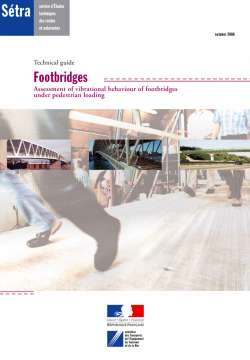 Description These guidelines round up the state of current knowledge on dynamic behaviour of footbridges under pedestrian loading. An analytical methodology and recommendations are also proposed to guide the designer of a new footbridge when considering the resulting dynamic effects. The methodology is based on the footbridge classification concept (as a function of traffic level) and on the required comfort level and relies on interpretation of results obtained from tests performed on the Solferino footbridge and on an experimental platform. These guidelines are aimed at Owners, designers and engineers. This document covers the following topics: * a description of the dynamic phenomena specific to footbridges and identification of the parameters which have an impact on the dimensioning of such structures; * a methodology for the dynamic analysis of footbridges based on a classification according to the traffic level; * a presentation of the practical methods for calculation of natural frequencies and modes, as well as structural response to loading; * recommendations for the drafting of design and construction documents. Supplementary theoretical (reminder of structural dynamics, pedestrian load modelling) and practical (damping systems, examples of recent footbridges, typical calculations) data are also provided in the guideline appendices. Download
|
dell001, netsonicyxf, stosto6666, Williams, | ||
| 14.09.2023 - 07:32 | Строительное проектирование | Tunnel Design Methods, 1st Edition CRC Press, 2023 pdf, 626 pages, English ISBN: 9781032358444  Description Tunnel Design Methods covers analytical, numerical, and empirical methods for the design of tunnels in soil and in rock. The material is intended for design engineers looking for detailed methods, for graduate students who are interested in tunnelling, and for researchers working on various aspects of ground-support interaction under static and seismic loading. The book is divided into seven chapters, covering fundamental concepts on ground and support behavior and on ground-excavation-support interaction and provides detailed information on analytical and numerical methods used for the design of tunnels, with applications, and on the latest developments on empirical methods. The principles and formulations included are used, throughout the book, to provide insight into the response of tunnels under both simple and complex loading conditions, thus providing the reader with fundamental understanding of tunnel behavior. Both authors have experience in tunnelling and have worked extensively in practice, designing tunnels both in the United States and abroad, and in research. Download |
Kong chandamuny, ronyleonel, Williams, | ||
| 13.09.2023 - 11:53 | Строительное проектирование | Design Guide 39: End-Plate Moment Connections American Institute of Steel Construction, 2023 pdf, 404 pages, English ISBN: -  Description End-plate moment connections are a simple approach to provide a quick-to-erect fully rigid connection without the need for field welding. This Design Guide centralizes AISC’s existing design procedures for end-plate moment connections (Design Guides 4, 16, and AISC 358-22 Chapter 6) into a single consistent document. It includes an extensive literature review, thorough discussions of design concepts, updated design procedures consistent with the latest research, and many (33!) design examples. The design procedures now also cover an expanded 15 end-plate configurations. This Design Guide serves as the comprehensive resource for the understanding and design of end-plate moment connections. Download
|
Kong chandamuny, V_A_V, | ||
| 23.08.2023 - 09:01 | Строительное проектирование | Design Guide 38: SpeedCore Systems for Steel Structures American Institute of Steel Construction, 2023 pdf, 258 pages, English ISBN: -  Description There’s a new structural system on the block--and it shaved 10 months off the erection of a 58-story tower in Seattle! Design Guide 38 offers everything you need to know to harness the power of SpeedCore, a concrete-filled composite plate shear wall system that allows lightning-fast erection without waiting for concrete to cure. The guide covers coupled and uncoupled systems in planar, C-shaped, and I-shaped configurations. It also includes critical information about designing for wind, fire, and seismic considerations, along with extensive design examples. Download
Supplement Download
|
Kong chandamuny, lemoco, | ||
| 12.08.2023 - 08:37 | Строительное проектирование | Seismic Hazard and Risk Analysis Cambridge University Press, 2021 pdf, 579 pages, English ISBN: 978-1-108-42505-6 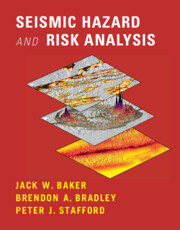 Description Seismic hazard and risk analyses underpin the loadings prescribed by engineering design codes, the decisions by asset owners to retrofit structures, the pricing of insurance policies, and many other activities. This is a comprehensive overview of the principles and procedures behind seismic hazard and risk analysis. It enables readers to understand best practises and future research directions. Early chapters cover the essential elements and concepts of seismic hazard and risk analysis, while later chapters shift focus to more advanced topics. Each chapter includes worked examples and problem sets for which full solutions are provided online. Appendices provide relevant background in probability and statistics. Computer codes are also available online to help replicate specific calculations and demonstrate the implementation of various methods. This is a valuable reference for upper level students and practitioners in civil engineering, and earth scientists interested in engineering seismology. Download
|
Kong chandamuny, Williams, | ||
| 15.07.2023 - 08:21 | Seismic Design and Analysis of Tanks | Seismic Design and Analysis of Tanks Gian Michele Calvi, Roberto Nascimbene 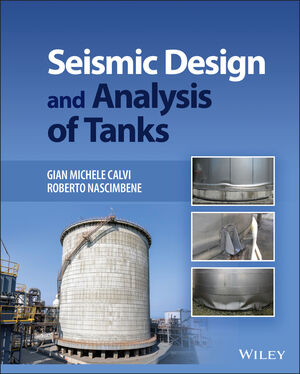 ISBN: 978-1-119-84982-7 Release on: February 2023 Total pages: 352 Pages DESCRIPTION Seismic Design and Analysis of Tanks A detailed view on the effects of seismic activity on tank structures As the use of above-ground and underground storage tanks (ASTs and USTs) continues to grow—with approximately 545,000 in the USA alone—the greatest threat to ASTs and USTs is earthquakes, causing the contamination of groundwater, a vital source of drinking water throughout the world. These tanks suffer a great deal of strain during an earthquake, as a complicated pattern of stress affects them, such that poorly designed tanks have leaked, buckled, or even collapsed during seismic events. Furthermore, in oil and gas industrial plants, the risk of damage is even more critical due to the effects of explosion, collapse, and air or soil contamination by chemical fluid spillages. Seismic Design and Analysis of Tanks provides the first in-depth discussion of the principles and applications of shell structure design and earthquake engineering analyses focused on tank structures, and it explains how these methodologies can help prevent the destruction of ASTs and USTs during earthquakes. Providing a thorough examination of the design, analysis, and performance of steel, reinforced concrete, and precast tanks, this book takes a look at tanks that are above-ground, underground, or elevated, anchored and unanchored, and rigid or flexible, and evaluates the efficacy of each method during times of seismic shaking—and it does so without getting bogged down in impenetrable mathematics and theory. Seismic Design and Analysis of Tanks readers will also find: A global approach to the best analytical and practical solutions available in each region: discussion of the latest US codes and standards from the American Society of Civil Engineers (ACSE 7), the American Concrete Institute (ACI 350,3, 371.R), the American Water Works Association (AWWA D100, D110, D115), and the American Petroleum Institute (API 650) an overview of the European codes and standards, including Eurocode 8-4 and CEN-EN 14015 Hundreds of step-by-step equations, accompanied by illustrations Photographs illustrating real-world damage to tanks caused by seismic events Perfect for practising structural engineers, geotechnical engineers, civil engineers, and engineers of all kinds who are responsible for the design, analysis, and performance of tanks and their foundations—as well as students studying engineering—Seismic Design and Analysis of Tanks is a landmark text, the first work of its kind to deal with the seismic engineering performance of all types of storage tanks. DOWNLOAD https://anonfiles.com/B6Ueq524z8/Seismic_Design_and_Analysis_of_Tanks_Calvi_2023_pdf |
ceLebi, joney11, Kong chandamuny, totolemoco, | ||

|
Текстовая версия | Сейчас: 19.10.2025 - 18:56 |